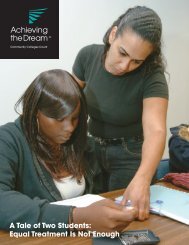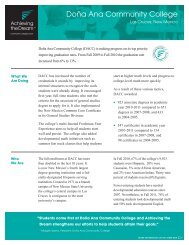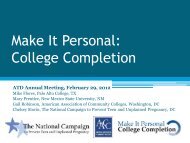Wayne County Community College District - Achieving the Dream
Wayne County Community College District - Achieving the Dream
Wayne County Community College District - Achieving the Dream
You also want an ePaper? Increase the reach of your titles
YUMPU automatically turns print PDFs into web optimized ePapers that Google loves.
<strong>Wayne</strong> <strong>County</strong> El <strong>Community</strong> Paso <strong>Community</strong> <strong>College</strong> <strong>College</strong> <strong>District</strong><br />
Detroit, El Paso, Michigan Texas<br />
<strong>Wayne</strong> <strong>County</strong> <strong>Community</strong> <strong>College</strong> <strong>District</strong> (WCCCD) expanded its Early Alert<br />
System in Spring 2011 to include all students in developmental English and<br />
ma<strong>the</strong>matics courses and college-level learning community courses.<br />
What We<br />
Are Doing<br />
WCCCD’s Early Alert System uses<br />
high technology and personal contacts<br />
to encourage student persistence.<br />
Faculty members use <strong>the</strong> college’s<br />
database to alert Student Services<br />
about any student who has a grade<br />
who has a grade below a C after<br />
<strong>the</strong> first four weeks of <strong>the</strong> semester.<br />
Student Services personnel <strong>the</strong>n<br />
provide intrusive outreach to <strong>the</strong><br />
identified students and refer students<br />
to success resources and programs<br />
to help <strong>the</strong>m achieve better grades.<br />
Outreach methods also include class<br />
questionnaires and telephone calls to<br />
encourage students to use support services<br />
to improve <strong>the</strong>ir grades.<br />
AA<br />
AA<br />
AA<br />
In Fall 2008, 591 students were<br />
in <strong>the</strong> Early Alert System<br />
In Fall 2010, 3,152 students or<br />
15% of <strong>the</strong> total enrollment were<br />
in <strong>the</strong> system<br />
In Spring 2011, 8,353 students or<br />
nearly 20% of <strong>the</strong> college’s total<br />
enrollment were involved when <strong>the</strong><br />
Early Alert System was scaled to<br />
include English 111, English 115,<br />
and MATH 105 on all five campuses<br />
Who<br />
We Are<br />
WCCCD’s five comprehensive campuses<br />
serve residents of 32 cities and townships<br />
in sou<strong>the</strong>astern Michigan.<br />
In Fall 2010, <strong>the</strong> college enrolled approximately<br />
21,200 credit students and of <strong>the</strong>se<br />
students, 69% were women, 57% were<br />
African American, and 1% was Hispanic.<br />
However, 22% of students reported <strong>the</strong>ir<br />
race as “unknown.” Sixty-four percent<br />
of students received Pell grants.<br />
<strong>Achieving</strong> <strong>the</strong> <strong>Dream</strong> is a regular feature of<br />
<strong>the</strong> chancellor’s cabinet meetings and his<br />
immediate priority meetings, and <strong>the</strong><br />
college-wide Professional Development<br />
day for faculty. Student Success strategies<br />
were also <strong>the</strong> topic of discussion for facultyled<br />
conferences on learning communities<br />
and integrated learning.<br />
Some faculty have also received professional<br />
development by attending <strong>the</strong> “Designing<br />
and Building a Learning <strong>Community</strong><br />
Program: <strong>the</strong> Kingsborough Model” to<br />
help WCCCD’s strive toward helping<br />
students succeed.<br />
“<strong>Achieving</strong> <strong>the</strong> <strong>Dream</strong> is helping us reinvent <strong>the</strong> open door as we<br />
respond to students’ needs amid dramatic economic changes in<br />
our communities.”<br />
– Curtis L. Ivery, Chancellor, <strong>Wayne</strong> <strong>County</strong> Communty <strong>College</strong> <strong>District</strong><br />
more information on <strong>the</strong> o<strong>the</strong>r side w
How We<br />
Work<br />
Based on <strong>the</strong> promising results with students<br />
in Learning Communities that link an English<br />
course with political science or psychology<br />
courses, WCCCD expanded Learning Communities<br />
of various course linkages to all<br />
five campuses.<br />
O<strong>the</strong>r systemic student success<br />
efforts include:<br />
AA<br />
<strong>Dream</strong>keepers, which helps students<br />
stay in college when faced with an unforeseen<br />
financial emergency. It provides<br />
students <strong>the</strong> resources and tools <strong>the</strong>y need<br />
AA<br />
AA<br />
AA<br />
to help reach <strong>the</strong>ir educational goals.<br />
The Student Retention Center, which<br />
utilizes staff members from <strong>the</strong> Bursar’s<br />
Office, Financial Aid, and Student Services<br />
to serve <strong>the</strong> students district-wide.<br />
Integrating intrusive advising strategies<br />
such as our Early Alert System.<br />
The YMCA Education Coalition, a<br />
partnership of several universities and<br />
colleges including WCCCD, provides<br />
high school students with college<br />
readiness workshops.<br />
<strong>Achieving</strong><br />
<strong>the</strong> <strong>Dream</strong><br />
Model<br />
<strong>Achieving</strong><br />
<strong>the</strong> <strong>Dream</strong><br />
Leader<br />
<strong>College</strong>s<br />
<strong>Achieving</strong> <strong>the</strong> <strong>Dream</strong> community colleges<br />
commit to our Student-Centered Model of<br />
Institutional Improvement. Based on four<br />
principles, <strong>the</strong> model frames <strong>the</strong> overall work<br />
of helping more students, particularly lowincome<br />
students and students of color, stay in<br />
school and earn a college certificate or degree.<br />
Each college approaches <strong>the</strong> work differently,<br />
but <strong>Achieving</strong> <strong>the</strong> <strong>Dream</strong>’s five-step process<br />
provides practical guidelines for keeping<br />
<strong>the</strong> focus where it belongs and building<br />
momentum over time. Throughout <strong>the</strong> process,<br />
<strong>Achieving</strong> <strong>the</strong> <strong>Dream</strong> coaches offer customized<br />
support and help each college’s core<br />
team implement data-informed programs and<br />
policies that build long-term, institution-wide<br />
commitment to student success.<br />
Leader <strong>College</strong>s are demonstrating <strong>the</strong> power<br />
of <strong>the</strong> <strong>Achieving</strong> <strong>the</strong> <strong>Dream</strong> Student-Centered<br />
Model of Institutional Improvement. They<br />
show us it is possible to raise persistence and<br />
graduation rates, close achievement gaps,<br />
and change lives. Leader <strong>College</strong>s embody<br />
<strong>the</strong> ultimate goal of <strong>Achieving</strong> <strong>the</strong> <strong>Dream</strong>,<br />
and as such, serve as mentors within our<br />
community of learners.<br />
To be eligible for Leader <strong>College</strong> distinction,<br />
colleges must show three or more years<br />
For more information, visit<br />
www.achieving<strong>the</strong>dream.org or<br />
contact info@achieving<strong>the</strong>dream.org<br />
or 1-855-AT<strong>Dream</strong><br />
4 Principles<br />
EE<br />
Committed leadership<br />
EE<br />
Using evidence to improve programs & services<br />
EE<br />
Broad engagement<br />
EE<br />
Systemic institutional improvement<br />
5 Steps<br />
STEP 5<br />
Establish a<br />
culture of<br />
continuous<br />
improvement.<br />
STEP 4<br />
Implement,<br />
evaluate,<br />
improve.<br />
STEP 1<br />
Commit<br />
to change.<br />
1 Goal: Student success.<br />
STEP 2<br />
Use data<br />
to prioritize<br />
actions.<br />
STEP 3<br />
Engage<br />
stakeholders.<br />
of improvement on one or more of <strong>the</strong>se<br />
five measures:<br />
AA<br />
Course completion<br />
AA<br />
Advancement from developmental to<br />
credit-bearing courses<br />
AA<br />
Completion of college-level math and<br />
English courses<br />
AA<br />
Term-to-term and year-to-year retention<br />
AA<br />
Completion of certificates or degrees<br />
Last updated 9/2011








